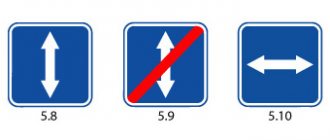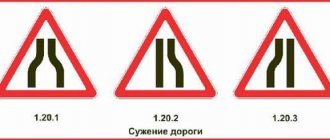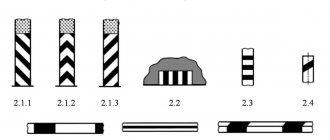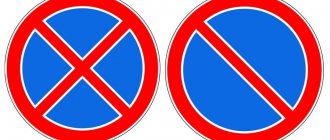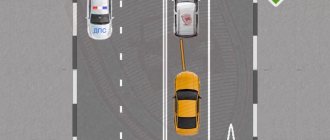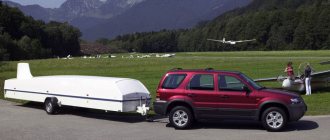Summary
Questions
1. Is through traffic allowed through the yard?
1.1. Decree of the Government of the Russian Federation “On Traffic Rules” 17. Traffic in residential areas 17.1. In a residential area, that is, in an area whose entrances and exits are indicated by signs 5.21 and 5.22, pedestrian movement is permitted both on sidewalks and on the roadway. In residential areas, pedestrians have the right of way, but they must not unreasonably interfere with vehicular traffic. 17.2. In a residential area, through traffic, practice driving, parking with the engine running, as well as parking of trucks with a permissible maximum weight of more than 3.5 tons outside specially designated areas and marked with signs and (or) markings are prohibited. 17.3. When leaving a residential area, drivers must give way to other road users. 17.4. The requirements of this section also apply to courtyard areas.
2. Please tell me, when taking the exam at the traffic police, I drove into the parking lot of a store, the residential zone sign was further away, I didn’t cross it, and when leaving another exit there was a sign for the end of the residential zone, they gave me a failure, saying through traffic, is this legal? Thank you in advance!
2.1. Hello, Mikhail! This decision is illegal. You can appeal it.
3. When taking an exam at the traffic police, I drove into a parking lot near a store (a place to stop), drove into one lane where the residential zone sign was far away, and did not cross it, but drove out of another, nearby, but when exiting it was already closer to the roadway there was a sign for the end of the residential area, they put a failure and said through traffic, and the second time I was driving, the green light flashed so as not to brake sharply, I stopped with my front wheels behind the stop line, and also failed, is this legal? Thank you in advance!
3.1. Hello. If you drove beyond the stop line at a traffic light and stopped behind it, then this means you stopped at the intersection, although you should have left it.
4. In the village, the street was previously a through street, then it became a dead end due to the decision of the administration, there is no lighting, the road is well-trodden by transport. In the fall and spring, cars constantly get stuck in through traffic. It was still possible to get out of what standards regulate the requirements for streets.
4.1. Andrey, I advise you to write a complaint to the prosecutor’s office. Let them deal with this issue. Sincerely.
5. Is it possible to install concrete hemispheres that prevent cars from neighboring houses from passing through the residential area and ensure traffic safety, but do not impede the passage of a fire truck or ambulance?
5.1. This cannot be done. What if the police need to pass? What if the person just feels bad and is driven in a regular car? Tell the traffic police that you have a fishing place on a through passage, I think they will often stand there waiting for customers.
6. Residents of two houses in the city of Mytishchi Station building 5 and 5 to 1 want to install 3 barriers, thereby limiting through traffic and parking of unauthorized persons. How to properly obtain permission and resolve complaints from residents of neighboring houses?
6.1. 1. Properly hold a general meeting of the owners of each apartment building who are installing a barrier. 2. Arrange everything properly. Collect funds, conclude an agreement and place a bet.
7. Does clause 17.2 of the traffic rules imply the installation of concrete blocks in the residential area to eliminate through passage.
7.1. Decree of the Government of the Russian Federation dated October 23, 1993 N 1090 (as amended on February 13, 2018) “On the Rules of the Road” (together with the “Basic provisions for the admission of vehicles to operation and the duties of officials to ensure safety. Article 17. Traffic in residential zones. Pass-through passage through a residential area or courtyards is prohibited by the rules. However, unauthorized installation of blocks to eliminate through passage is prohibited...
8. There is a local street in a city microdistrict (private sector). The territorial public self-government operating on a given street makes a decision to close transit/through traffic on this street (the decision is justified and legal, as confirmed by a letter from the traffic police). Is the city administration obliged to change the organization of traffic on this street in accordance with the decision of the TOS, or is such a decision only advisory in nature for the administration?
8.1. Good afternoon, Mikhail! I don’t think that the decision of the TOS has a binding effect on the city administration. All the same, the urban microdistrict is under the responsibility of the city administration, and the placement and use of roads falls under the competence of district or city entities. The decision must be made at the session. Let TOS write a petition to the administration.
Pedestrian traffic in residential areas
Rules for moving through a residential area exist not only for drivers, but also for pedestrians. It is people on foot who are the most vulnerable road users, and, undoubtedly, should not forget about its rules along with drivers. If you are a participant in traffic in a residential area, you should remember certain recommendations.
- Do not interfere with the movement of cars on the roadway unless absolutely necessary.
- Use sidewalks whenever possible.
- Pay attention to traffic lights, use pedestrian crossings.
- Be vigilant in bad weather (fog, ice, heavy rain, slippery roads or poor visibility): even at low speed in such conditions, the driver may not notice you in time and may not have time to brake.
- Be polite and calmly cross the road.
- Supervise small children crossing the road.
By adhering to these simple rules, you will not create any problems for yourself or the driver, and most importantly, save life and health when driving in residential areas. Knowing the rules of the road is your best defense when moving around the city. And ignorance of them not only will not free you from responsibility, but can also lead to various oddities, unpleasant situations and even tragedies.
Definition of the concept of Residential Zone
Traffic rules
The exact definition is given in the Town Planning Code of the Russian Federation.
This document is quite lengthy, so we will give a term that directly concerns drivers:
“A specially developed area where special traffic regulations apply. Entrances and exits are marked with signs 5.21 and 5.22, respectively.”
Already from the name it is clear that such areas are located within residential areas, in areas where multi-storey or private houses are built. The main advantage in movement here is given to pedestrians and cyclists, therefore serious restrictions apply, including:
- to the speed of movement of vehicles;
- to the rules of stopping and parking;
- to exit and entry.
It should also be noted that these requirements are relevant for courtyards and adjacent territories, however, the Civil Code of the Russian Federation and traffic rules do not provide a definition of the terms “household or courtyard areas”. Thus, you need to focus on signs 5.21 and 5.22. If they are not there, then a speed limit sign is usually posted: 3.29 to 20 or 5 kilometers per hour.
An important point is that traffic police and traffic police patrol cars rarely enter the courtyards of houses, so drivers often take advantage of this by exceeding the speed limit and placing their vehicles on playgrounds and lawns.
Residents of houses can teach violators a lesson by reporting this, for example, through the application form on the official website of the traffic police.
Features of driving in residential and yard areas
Traffic Laws. List of main problems
Most drivers are not aware that a yard and a residential area have some significant differences, and there are rules for each of these concepts, so it is worthwhile to firmly understand the differences between these definitions. The traffic rules in paragraph 17.4 state that all paragraphs of this section, called “Traffic in residential areas,” are fully transferred to the wording “yard areas.”
However, the concepts themselves are not the same and these are different areas, although people live in both. There are even different visual signs to differentiate the traffic rules, which means that the residential area is different from the courtyard area. As for the concept of “yard territory”, there is simply no clear formulation and explanation in the traffic rules.
To leave courtyard areas or residential areas, there are requirements defined by traffic rules
However, the courtyard area may be included in the area of the residential area, in turn, the residential area can also be a certain part of the courtyard area. Apparently, this is why in the traffic rules, in section 17, unifying rules for both territories and zones were introduced, although this did not make the difference any clearer. But the remaining sections of the traffic rules cannot be summed up under a single line; they relate only to a certain territory, which is directly discussed in a separate paragraph of the rules.
For leaving courtyard areas or residential areas, there are requirements defined by traffic rules. When leaving the courtyard area, the driver is obliged to let anyone who is at that moment taking part in movement next to, in front of or behind the car pass. According to the current rules, clause 10.2, it is allowed to move in residential areas and courtyards at a speed of no more than 20 km/h.
According to traffic rules, driving through courtyards and residential areas in drafts is prohibited, but at the same time, who can catch you in this, if you are driving through, stop in the courtyard and, without turning off the engine, move on in 10 seconds. In this case, no one will accuse you of violating the rules and there is nothing to fine you for.
The amount of the fine varies in different regions of residence in St. Petersburg and Moscow, the amount ranges from 1,500 to 3 thousand rubles
Fines for violations in residential areas
The amount of the fine varies in different regions of residence. In St. Petersburg and Moscow, the amount ranges from 1,500 to 3 thousand rubles.
Deprivation of a driver's license occurs in case of gross violations of traffic rules - exceeding the speed of movement in a residential area up to 80 km/h. The driver's license is taken away for 12 months.
Drivers of cars and trucks must move correctly both in the yard and when leaving it. Sanctions for violation are also imposed in the absence of the 5.21 sign in the yard.
https://carnovato.ru/znak-zhilaja-zona-pdd/
Yard area sign
17. Traffic in residential areas
Section 17. Traffic rules in residential areas
autopravilo.ru/pdd/dorozhnyj-znak-zhilaya-zona-chto-oznachaet-i-gde-ustanavlivaetsya.html
https://www.argo-avto.ru/summary/traffic-laws/highway-code/section-17/
https://www.autoshcool.ru/4757-pravila-dorozhnogo-dvizheniya-dlya-zhiloy-zony-i-dvorovoy-territorii.html
Parking and parking
The rules also regulate special conditions for parking and parking inside courtyards and residential areas.
For passenger cars
As we said earlier, passenger cars, as well as trucks that weigh less than 3.5 tons (for example, small Gazelles), are allowed to stop in residential areas.
A stop means a cessation of movement for a period of less than 5 minutes, or for any time if the stop is related to the embarkation or disembarkation of citizens, or the loading or unloading of a vehicle.
Parking of passenger cars is also permitted, provided that it is done without the engine running.
Otherwise, no special rules have been established; accordingly, the general provisions of the Rules, regulated by Section 12, apply.
For freight
Trucks weighing over 3500 kg are not prohibited from stopping - they are prohibited from standing (that is, stopping movement for more than 5 minutes, if this is not related to boarding/disembarking/loading/loading).
Otherwise, the same rules apply to trucks as to cars (you need to give way to pedestrians everywhere within a residential area, when leaving it - give way to all other road users, do not drive more than 20 km/h, etc.) .
About the rules for motorcyclists
Traffic signs
For motorized transport, the set of rules is the same as for its other types. Only issues related to evacuation, as well as the accrual of fines for violations, are resolved slightly differently.
They stop any motorcycles that maintain a maximum speed of 50 kilometers per hour and with an engine capacity of 50 cm3 or more. Inspectors must show a document confirming ownership of the motorcycle. This is usually a sales and purchase agreement or an invoice.
The first punishment will be warnings or a 500-800 ruble fine. If the violation occurs again, the driver will have to pay 5 thousand. Or lose your rights for a period of 1 to 3 months.
In 2014, another additional rule was introduced regarding parking violations. According to this addition, a car owner will not be able to travel outside the country if he has accumulated fines in the amount of up to 10 thousand rubles. He will be stopped at customs if he tries to do this.
Problems often arise due to the fact that violators do not know the amount of accumulated fines. This happens when written notice is not received.
Motorcycle drivers must use the pedestrian zone for parking only. Traveling on it with running engines is strictly prohibited.
It is also important to take into account such an issue as convenience for pedestrians.
Specific violations and amounts
In Russia, fines for pedestrians for violating traffic rules are clearly regulated if traffic police officers see and detain the person in time. Of course, in a dispute you can prove that you are right, but it is better to simply not commit offenses.
For what violations can a person receive a fine?
There are a number of serious violations for which a pedestrian can receive a considerable fine:
- The first and simplest violation, which is considered gross, according to the traffic rules, is a pedestrian crossing the roadway at a red traffic light. Despite the seemingly frivolous nature, this offense can result in a serious accident, injury, and even death. The amount of the fine is 500 rubles.
- Every pedestrian should know the meaning of traffic controller gestures. They are not difficult to learn, especially those related to pedestrian traffic. If you make a mistake, you can receive a fine of 500 rubles.
- If a person crosses the street near the crossing, and not along it, this is also a violation, since the traffic rules regard this as a violation on the part of the pedestrian: interfering with cars. The fine is also 500 rubles.
- As you know, you need to bypass a bus vehicle from behind, and a tram vehicle - from the front. For a pedestrian violating this traffic rule, a fine of 500 rubles is also imposed.
- If a person moves in an area where pedestrian traffic is prohibited. Such zones are marked with special signs. For such violations the fine is 500 rubles.
- If a pedestrian ignores a car with a flashing beacon and sirens on and does not let it pass, then he will also receive a fine of 500 rubles.
- You can exit a taxi onto the roadway only on the pedestrian sidewalk. If you step out of a taxi onto the road, you will be fined 500 rubles.
- Fine in the amount of 500 rubles. assigned when moving along the roadway if there is a sidewalk (shoulder) nearby.
There are also large amounts of fines, they are possible if:
- a pedestrian who interferes with traffic in case of violation - 1000 rubles;
- the violation caused harm to the health of the victim (mild or moderate) - from 1000 to 1500 rubles.
The traffic rules for pedestrians and cyclists described above are quite easy to follow. A person just needs to be attentive, careful enough and have basic knowledge to avoid any troubles on the roads. Knowing these simple rules, everyone can ensure their safety.
- Regulator's instructions with explanations
- Payment of traffic fines with a 50 discount
- What is the fine if the license plate light does not light up?
- Fine for drivers for driving on the sidewalk
Pedestrians have priority
If a residential traffic zone sign appears in front of you, then it requires you to change your driving behavior. First of all, you should forget about all the advantages that you had previously.
According to the law, in the area where sign 5.21 is in effect, no vehicle should interfere with pedestrians who actually have the right to move along the roadway.
If the driver sees a residential traffic zone sign, in this case they are required to give way to pedestrians and cyclists. The latter should also not specifically interfere with the passage of vehicles, otherwise this will be regarded as a serious violation.
Having understood what a residential area is, it is worth finding out what restrictions are imposed on the mode of transport movement in it. The driver should enter a residential area only when necessary. This way you can not only avoid punishment in the form of a fine, but also facilitate the movement of pedestrians and reduce risks for people living in the area.
If you see a familiar road sign and realize that you have entered a residential area, you need to understand that you are obliged to give way to everyone. It is important to maintain a speed limit of 20 km/h and park only in designated areas.
Living sector
| General plan of the central estate of the state farm. |
The residential area, depending on the size of the village, is located in a single complex or several areas united by a public center.
Residential zones are intended for development with multi-storey apartment buildings, low- and medium-rise residential buildings, individual houses with private land plots. The residential zone is located, as a rule, on the windward side upstream of the rivers in relation to industrial and agricultural enterprises.
Residential zones are intended for construction with multi-storey multi-apartment residential buildings, low- and medium-rise residential buildings, individual houses with private land plots.
Residential zones are intended for development with multi-storey apartment buildings, low- and medium-rise residential buildings, individual houses with private land plots. The residential zone is located, as a rule, on the windward side upstream of the rivers in relation to industrial and agricultural enterprises.
The residential area is located on the windward side for the prevailing winds, as well as upstream of the rivers in relation to industrial and agricultural enterprises with technological processes that are a source of release of harmful and unpleasant-smelling substances into the environment. The prevailing wind direction is determined by the average wind rose for the summer and winter periods of the year (taking into account the daily cycle) based on long-term observation data from hydrometeorological stations. In areas with opposite directions of prevailing winds in the summer and winter periods of the year, residential areas are located to the left and right of the indicated wind directions in relation to industrial enterprises.
The residential area is located on the windward side for the prevailing winds, as well as upstream of rivers in relation to industrial and agricultural enterprises with technological processes that are sources of release of harmful and unpleasant-smelling substances into the environment. The prevailing wind direction is determined by the average wind rose for the summer and winter periods of the year (taking into account the daily cycle) based on long-term observation data from stations of the USSR State Committee for Hydrometeorology and Environmental Control.
The residential area is located on the windward side for the prevailing winds, as well as upstream of rivers in relation to industrial and agricultural enterprises with technological processes that are sources of release of harmful and unpleasant-smelling substances into the environment. The prevailing wind direction is determined by the average wind rose for the summer and winter periods of the year (taking into account the daily cycle) based on long-term observation data from stations of the USSR State Committee for Hydrometeorology and Environmental Control.
Independent residential zones have been interestingly solved in the projects of university complexes in Tallinn, Tbilisi, and Vilnius. The clear rectangular planning structure of the educational and scientific buildings in Tbilisi is well complemented by stepped dormitory buildings located against the backdrop of a mountain range and connected to the educational buildings by a bridge across a mountain river.
Warehouses and enterprises are located outside the residential area.
Protection of the air basin of a city's residential area from pollution by carbon monoxide generated during production, technological processes at metallurgical and other enterprises can be achieved by capturing and burning this gas to form carbon dioxide.
Shopping centers in residential areas, servicing, thousand people.
In small settlements, the residential area is located along one or two streets with two-sided buildings. In large settlements, the residential area is concentrated on several streets, divided into separate blocks, with two-, three- and four-sided buildings.
Planning measures to protect the air in a residential area include a clear functional division of the city’s transport routes with the removal of intensive traffic flows outside the residential areas, and transit flows outside the city, rational development of streets, the use of gas-protective green spaces, construction of transport interchanges on main highways with the construction of tunnels, taking into account the need for transport services when locating various enterprises and institutions in a residential area.
Residential buildings must be located in a residential area in accordance with the functional zoning of the territory of the settlement. It is allowed to place residential buildings in green, resort and recreational areas.
Why should parking in courtyards be organized according to the rules?
Firstly, crookedly positioned cars impede the passage of large vehicles. Garbage trucks that take out garbage in the morning (by the way, an article about rights and responsibilities in the housing and communal services sector), trucks, owners of large vehicles - they all suffer inconvenience. But the worst thing is that closely parked cars often do not allow ambulances and firefighters to pass.
Secondly, parking on lawns and playgrounds causes residents a lot of inconvenience. Children, while playing, bump into a car and can damage it, and those who like to park on lawns spoil the aesthetic appearance of the yard and spread dirt throughout the area.
Rules
Now it’s time to talk about how a car enthusiast should behave when he finds himself in the yard, and what restrictions apply to him.
Paragraph
Information on how to behave in the courtyard of a multi-storey building is described in paragraph number 17 of the code of traffic rules. It is worth noting that in this section you will not find a detailed description of what can be considered a residential area and what cannot. Therefore, we will rely on existence and by this term we will understand the space designated by these labels.
Prohibited
The rules of behavior in the yard come down to several prohibitions. They relate to the speed limit of the car, methods of stopping and parking, methods of routing and other driver manipulations.
Now let’s take a closer look at what the “Residential Zone” sign prohibits.
First of all, it is worth noting that after driving into the area marked , the driver will have to come to terms with the fact that a pedestrian has the right of way on the road.
You cannot rush a person walking along the roadway. And, of course, you cannot sound a sound signal in the yard (especially since in the city it is completely prohibited, except in cases of preventing road accidents).
- Even if there are no people nearby, you can drive around the yard no faster than 20 kilometers per hour.
- It is strictly prohibited to drive through the yard. That is, those “resourceful” drivers who are accustomed to avoiding traffic jams regularly violate traffic rules.
But this point has a small “loophole”. The fact is that if you stop in the courtyard through which you are passing for three minutes, then your movement will no longer be considered a through passage.
- It is highly undesirable to maneuver in such areas. For example, turning around or driving in reverse.
- Training vehicles are not allowed in the yard.
- You cannot park there with the engine running. Therefore, if you stop your car for more than five minutes in a residential area, hurry to turn off the engine.
- Most often in yards whose weight exceeds 3.5 tons. These are cars of category C. However, sometimes special signs are installed at the entrance to the yard, which indicate that such cars can pass.
Let us make a reservation that such a restriction does not apply in any way to vehicles intended for the work and movement of public utilities.
This section of the rules does not say anything about parking on the lawn. However, this requirement is described in another section. We remind you that the rules prohibit parking on the lawn and driving onto the curb.
Departure
The road along which you leave the described area is always considered a secondary road. Therefore, when turning out from there, you need to give priority to other road users.
If there is a continuous marking line, crossing it is prohibited. Even if you need to turn left, you will have to first steer to the right, and then wait for the area where the solid line breaks, and only then turn into the desired lane.
Punishment
Now let's talk about what you can pay for not complying with the requirements described above.
- Monetary fines. You can “get off” with a fine for the following violations: through passage, parking on the lawn or playground, failure to comply with the rules for entering or leaving the territory, parking with the engine running, speeding by 20–60 kilometers per hour. The amount of the fine for such violations depends on the region in which non-compliance with the rules was registered.
- Revocation of driver's license. You can lose your driver's license if you exceed the speed limit by more than 60 kilometers per hour. However, in a rare yard you can accelerate to 80 kilometers per hour or higher.
Who exercises control?
Let us note that many people neglect not only fulfilling, but also studying these requirements. Such people know that traffic police officers and representatives of the road safety inspection very rarely look into residential areas. This fact gives some drivers a false sense of impunity.
Cars are rightful masters on the roads. A pedestrian feels uncomfortable crossing traffic. In the residential area the situation is reversed. Here, the convenience and safety of citizens is more important than the convenience of the motorist.
The rules of the State Traffic Inspectorate enshrine the concept of a residential zone. Strict measures are applied to rule violators: deprivation of rights, fines. However, many drivers poorly understand the purpose of the network of local roads within such a zone and use them for through travel.
Traffic rules for residential areas and courtyards
Good afternoon, dear residents of the village “Western Meadows”
Of course, you noticed that at the entrance to the village there is a “Residential Zone” sign. Its presence determines the specific order of movement across the territory
However, the actual condition and regular complaints from residents indicate that for some reason drivers forget the correct driving order in a residential area.
To protect you from troubles and at the same time make living in the village more comfortable and safe, we present to your attention this material, prepared on the basis of existing Laws, rules and regulations, and of course common sense.
So, in the Traffic Rules there is a separate section devoted to traffic in courtyard areas: “Traffic in residential areas.”
We will remind you of the traffic rules related to traffic in residential areas, and also list the penalties for violating these rules.
Differences between the residential area and the courtyard area
Clause 17.4 of the traffic rules indicates that the requirements of section 17 “Traffic in residential areas” also apply to courtyard areas. However, this does not indicate that these concepts mean the same thing.
The residential area is indicated by the appropriate signs:
The definition of a residential area does not always correspond to the definition of a courtyard area.
The residential area may be part of the courtyard area. The reverse is also true; a courtyard area can be part of a residential area.
So, the rules of Section 17 apply to both courtyard areas and residential areas. As for the clauses of the remaining sections of the rules, they can only apply to the territory that is directly indicated in the selected clause.
Rules for parking in the courtyards of residential buildings
Naturally, in courtyard areas and in residential areas, all the same traffic rules apply as on a regular road, but there are some features:
- Parking with the engine running is prohibited.
- Parking of trucks is prohibited.
Parking with the engine running is prohibited in residential areas and yard areas. If the vehicle does not move for more than 5 minutes and no passengers are boarded or cargo is unloaded, then it is parked.
If during the cold season you warm up the car for 5 minutes or more, then you are violating the requirements of the rules, and a traffic police fine may be imposed on you.
Parking rules in yards prohibit the parking of trucks with a permissible maximum weight of more than 3.5 tons, i.e. cars of category C, outside specially designated areas (marked by road signs or markings).
It is also prohibited to park a car on the lawn in the courtyard area. The fine for parking on the lawn depends on the region of the Russian Federation and can be quite large (several thousand rubles).
Leaving the yard or residential area
There are special requirements regarding leaving the yard or residential area. When leaving the courtyard area, the driver must give way to all road users.
It doesn't matter in which direction other road users are moving, they should all avoid causing interference.
Traffic speed in residential area
The maximum speed in a residential area or in a yard is currently 20 km/h (clause 10.2 of the traffic rules). At the same time, fines for speeding in a courtyard area do not differ from fines for other places, i.e. driving around the yard at a speed of 80 km/h will result in deprivation of your license.
Pedestrian priority
When moving through the courtyard area, pedestrians can move not only on sidewalks, but also on the roadway. Pedestrians have priority, i.e. Drivers in residential areas must give way to pedestrians.
At the same time, pedestrians should not create unreasonable interference with cars, i.e. for example, smoking in the middle of a narrow roadway when a fire truck with special signals is trying to enter the yard.
Well, the last rule relating to residential areas and courtyards prohibits training driving in them.
Fines for driving in residential areas
The size of the fine for speeding depends on how much the driver exceeded the permissible speed and can range from 500 rubles to deprivation of rights for 12 months.
The material was prepared with the help of our friend the Internet, we hope for your understanding and correct behavior on the roads of the neighborhood.
Features of traffic in a residential area
If you find yourself in an area where such a sign is installed, you should take a closer look at its operation and the behavior of a vehicle driver in such areas. By the way, if you have a similar sign in your yard, be sure to leave a comment.
see also
Car maintenance and repair: when to do it
- Departure. When leaving, drivers are required to comply with certain requirements. Before the maneuver, you must let all traffic participants pass. It does not matter which direction they are moving from;
- Directions Driving through a residential area on a drive-through basis is prohibited according to the rules. That is, you do not have the right to take a shortcut through the yard in order to get through a traffic jam faster, for example;
- If passengers need to be dropped off, this rule does not apply. But then the stop should not last more than 10-15 seconds;
- Parking. Trucks and cars with their engines running are not allowed to park. It is also prohibited to stop a vehicle on the lawn.
Regarding parking, it’s a completely separate issue. If you want, we will consider it separately sometime. I think you will be interested in knowing some details about this. Here it is logical to remember about the No Stopping signs, as well as the effect of the No Parking sign.
Is the yard considered a residential zone in the absence of sign 5.21 Residential zone
We need some minor advice from a traffic police officer who correctly interprets traffic rules.
Situation: a driver repairs and washes a personal car with the engine running in the courtyard of a residential building and half a meter (the width of the sidewalk) from a kindergarten with a lattice fence while children are walking; He refuses to turn off the engine, citing the absence of sign 5.21 “Residential area”. Questions: 1) Is it true that any yard is always a “residential area”, and here the installation of a sign is not necessary (taken here - link); 2) What regulates the inadmissibility of washing a car in courtyards and other unsuitable areas?
I’m not a traffic police officer, but I passed theory in driving school with flying colors.
Traffic in residential areas
17.1 In a residential area, that is, in an area whose entrances and exits are marked with signs 5.21 and 5.22, pedestrian movement is permitted both on sidewalks and on the roadway. In residential areas, pedestrians have the right of way, but they must not unreasonably interfere with vehicular traffic.
17.2 In a residential area, through traffic, practice driving, parking with the engine running, as well as parking of trucks with a permissible maximum weight of more than 3.5 tons outside specially designated and marked areas with signs and (or) markings is prohibited.
17.3 When leaving a residential area, drivers must give way to other road users.
17.4 The requirements of this section also apply to courtyard areas.
Clause 17.4 of the traffic rules indicates that the requirements of section 17 “Traffic in residential areas” also apply to courtyard areas. However, this does not indicate that these concepts mean the same thing.
Firstly, the residential area is indicated by appropriate signs
Those. The definition of a residential area does not always correspond to the definition of a courtyard area. By the way, the concept of courtyard territory is not defined at all in the traffic rules.
I note that the residential area may be part of the courtyard area. The reverse is also true; a courtyard area can be part of a residential area.
What it is
A residential zone is an area marked at the entrance and exit with a special sign. It includes courtyards in residential areas, the private sector, and individual streets in the business and shopping parts of the city.
The sign allows pedestrians to move freely, but cars can only move at a minimum speed.
In a courtyard or residential area, drivers are prohibited from certain actions. All of them are prescribed in the traffic rules, and they must be carefully studied so as not to violate them, since people’s lives depend on it.
What the “Residential zone” sign prohibits:
| Through traffic | Even if it would be easier for the driver to go around a difficult section of the road through the yard, this is prohibited. There are highways for such maneuvers |
| Training ride | People learning to drive may make unpredictable maneuvers that can lead to serious consequences. Even if a highly qualified instructor is sitting next to you, he cannot always predict and react in time to the cadet’s actions. In addition, the student does not yet know how to start, drive and drive a vehicle normally. This causes a lot of noise, which disturbs the peace of the people living in this area. If it is not possible to avoid leaving a residential area, then an instructor must take over control of the car. |
| Parking with the engine running | During operation, the engine produces harmful substances that people have to breathe. As soon as a vehicle enters a residential area, the driver is obliged to turn off the vehicle as quickly as possible |
| Truck parking | Such vehicles are large in size. The process of warming up such machines is quite large. They emit a lot of harmful substances into the atmosphere, which people have to breathe. It is obvious that heavy vehicles need to be allocated a special place |
Every driver must comply with traffic rules, including in residential areas. This is a rather dangerous section of the road, as this is where there is increased pedestrian traffic.
According to Russian legislation, a person will be punished for violating these rules. Residents of a residential area can independently call the patrol service to punish the culprit who violates the order.
